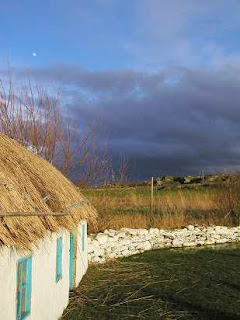 Photo: This turbine crashed to the ground near Carndonagh, causing over 1 million euro of damage.
Photo: This turbine crashed to the ground near Carndonagh, causing over 1 million euro of damage.
Photo: Derelict at Lough Eske Co. Donegal. Some houses might need a bit of work before they can withstand the pressure of a turbine being attatched to them.
There has been a report released recently that claims the new mini wind turbines could damage houses. The report also claims that they do not even produce enough electricity in towns and cities to keep a light bulb lit. A study commissioned by Building for a Future, a journal specialising in sustainable construction techniques, has found that rooftop turbines are plagued by technical problems and seldom generate significant amounts of power, especially in towns and cities.
The report finds that a typical rooftop turbine produces no more than a quarter of the average home’s power needs, at best, and that in urban areas this is likely to be more like 10%-15%, because wind blows around towns in turbulent, unpredictable gusts. In addition, older houses can face serious structural damage from the powerful sideways forces generated as the wind pushes against the turbines. This can be a particular problem if the turbines are mounted on chimneys. The other comment the report made was that it would take at least 15-25 years to generate enough electricity to repay the outlay of the turbine. One answer is to get a survey done on your chimney before you install. The other idea would be to put your turbine on a separate pole or out building like the example at the Dunree visitors centre. The manufacturers of these devices have always said that the turbines could be a danger to you property and to check the quality of the mountings first. The cost of the devices will come down as the demand increases and I’m sure that in Inishowen we can expect the wind here to make sure that the turbines will work at maximum velocity to pay for the devices in no time at all!
The amount of electricity that we use has increased by 40% in the last ten years and last year the ESB added 70 000 new households to their list of customers. Charges have also seen an increase of 20% in the last three years as well.
WIND POWER
On a personal level, from my kitchen window I can see six wind turbines. They are in the distance on the hills and I use them as a method of seeing which way the wind is blowing every morning when they aren’t covered in mist. Feelings run high when wind farms are proposed. The farms do have an effect on the hills or the coastline; opinions are divided as to whether it is an improvement or an eyesore.
At the moment wind turbines generate only a small percentage of power for the national grid. The power supply from any new turbines linking to the electricity grid has been stopped for the moment by the ESB. A couple of reasons have been used; one of them being that the power plants can’t cope with the fluctuating power depending on the strength of the wind.
Ireland faces a fine of €7,000,000,000 if they don’t comply with the CO2 reduction commitments of the Kyoto Protocol. One way to achieve the target set would be for us as a nation to reduce the amount of power we use. Turning off lights when they are not in use, not leaving the standby light glowing on the television and using low energy bulbs will all help to keep the demand from the fossil fuel power plants down to a minimum. The other way to help clean things up would be for us to produce some of our own electricity. We now have the opportunity to set up our own small wind turbine on our houses.
MINI WIND TURBINES
A company in Scotland have developed a mini turbine that can be attached to the house. We have just had a television aerial put up on our house and it’s a monster of a thing, (apparently we are in a bad area for a signal) reaching about ten feet into the air. So far no one has complained, as we are used to television aerials on houses. Most of us are now so familiar with satellite dishes that we don’t see them now either. The same could happen if we all fitted a wind turbine to our houses.
These new wind turbines only measure 3 feet by 2 feet and are silent when they are in operation. They cost in the region of 750 pounds sterling which is about €1250. The device is just a solid box with three blades that face into the prevailing wind. As far as I can see the only thing that will attract your attention to them are the blades when they spin around. These new turbines top up the existing mains supply and the company claims that it could save us about 15% of our annual electricity needs.
There is a system in place in England where the government give back money by subsidising the customer to produce electricity. The company that is making the turbines predict that the cost of the machine could be paid for in as little as 30 months.
The machine starts working when the wind reaches 3 miles per hour and is at it’s best at 20 mph, so we’ll have no bother around Inishowen keeping the turbines at full power!
As yet no planning permission is needed for the turbines and I can see them becoming very popular, especially if our government set a subsidy to pay customers for producing the natural electricity!










